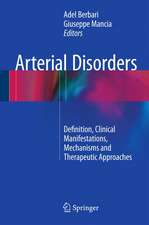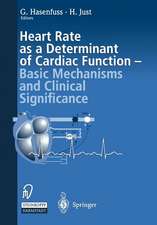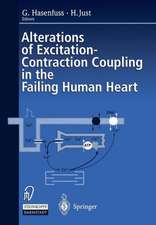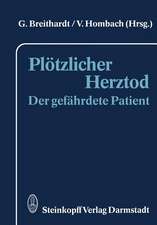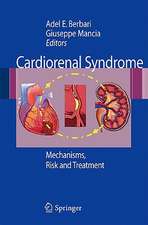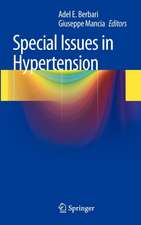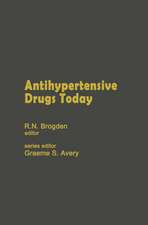Prehypertension and Cardiometabolic Syndrome: Updates in Hypertension and Cardiovascular Protection
Editat de Reuven Zimlichman, Stevo Julius, Giuseppe Manciaen Limba Engleză Hardback – 20 dec 2018
While the diagnostic and therapeutic approach to full-blown diabetes, hypertension, dyslipidemia and obesity is well defined, there is still a lack of clear understanding and guidelines as far as patients with borderline conditions – especially when multiple – are concerned. Moreover, end-organ damage depends on several factors, including genetic factors, making it difficult to predict its extent. As such, the gradual transition from a healthy subject to one with functional hemodynamic changes, and then one with structurally asymptomatic changes and lastly to overt disease needs further investigation.
In order to address these knowledge gaps, the book covers a broad variety of topics, making it a valuable tool for identifying which asymptomatic subjects could profit from being appropriately screened and at what stage. Furthermore it offers insights into better treating these patients to prevent their progression to overt disease. The book appeals to cardiologists, primary care physicians and all those healthcare professional looking to optimize the management of these complex and often undiagnosed cases.
Preț: 1428.48 lei
Preț vechi: 1503.66 lei
-5% Nou
Puncte Express: 2143
Preț estimativ în valută:
273.33€ • 286.91$ • 226.88£
273.33€ • 286.91$ • 226.88£
Carte tipărită la comandă
Livrare economică 07-14 aprilie
Preluare comenzi: 021 569.72.76
Specificații
ISBN-13: 9783319753096
ISBN-10: 3319753096
Pagini: 818
Ilustrații: XII, 689 p. 111 illus., 72 illus. in color.
Dimensiuni: 155 x 235 mm
Greutate: 1.5 kg
Ediția:1st ed. 2019
Editura: Springer International Publishing
Colecția Springer
Seria Updates in Hypertension and Cardiovascular Protection
Locul publicării:Cham, Switzerland
ISBN-10: 3319753096
Pagini: 818
Ilustrații: XII, 689 p. 111 illus., 72 illus. in color.
Dimensiuni: 155 x 235 mm
Greutate: 1.5 kg
Ediția:1st ed. 2019
Editura: Springer International Publishing
Colecția Springer
Seria Updates in Hypertension and Cardiovascular Protection
Locul publicării:Cham, Switzerland
Cuprins
I Epidemiology and Statistics.- 1 Epidemiology, statistics and health burden.- 2 PreHypertension, the risk of Hypertension and events.- 3 Parental history of hypertension as the determinant of cardiovascular function.- 4 High normal blood pressure in children and adolescents.- II Pathophysiology of prehypertension.- Part 1 Alteration of Cardiovascular control systems.- 5 Tachycardia in PreHypertension.- 6 Endothelial dysfunction in early phases of hypertension.- 7 Prehypertension and the Renin angiotensin aldosterone system.- 8 The role of the brain in neurogenic prehypertension.- 9 The blood pressure seeking property of the brain.- Part 2 Organ damage in Prehypertension.- 10 Microvascular structural alternations and tissue perfusion in hypertension and diabetes.-11 The heart in prehypertension.- 12 The role of the kidney in PreHypertension.- 13 Obesity, Hypertension and Chronic Kidney Disease: A Forty Year Retrospective.- 14 Pre-CKD? Early markers of renal dysfunction in patientswith Prehypertension.- 15 Arterial stiffness in early phases of Prehypertension.- 16 The role of perivascular fat in raising blood pressure in obesity and diabetes.- 17 The Brain.- 18 Diurnal and pulsatile hemodynamics in individuals with PreHypertension.- 19 Systolic hypertension in youth.- 20 Prehypertension and ethnicity: Haemodynamic mechanisms in young adults.- 21 Hemodynamics (systemic and renal) in prehypertension.- 22 Central blood pressure and Prehypertension.- Section 3: Risk assessment in PreHypertension.- 23 Blood pressure measurement, white coat and masked hypertension.-24 Vascular functional and structural risk assessment in prehypertension.- 25 Blood pressure variability.- 26 Morning Surge of Blood Pressure.- 27 Role of ambulatory Blood Pressure Monitoring in Prehypertension.- 28 Home blood pressure, prehypertension and hypertension.- 29 Blood pressure and atherosclerosis- subclinical arteriosclerosis as an early sign of organ damage.- 30 Response to stress, effortand cold pressor test as predictors of Prehypertension.- 31 Physical Activity and Exercise Training as Important Modifiers of Vascular Health.- 32 Prehypertension and associated metabolic risk factors.- IV End organ damage in PreHypertension.- 33 Early cardiovascular dysfunction in Prehypertension.- 34 Effect of blood pressure lowering in hypertensive rats.- V Clinical studies in PreHypertension.- 35 Review of "old and new studies" in the treatment of PreHypertension.- 36 The CHINON study- argument for early treatment of PreHypertension. Effect of age on progression of hypertension.- 37 The PREVER study.- 38 The TROPHY study.- VI Management of PreHypertension.- 39 Non-pharmacologic approaches for the management of prehypertension.- 40 Antihypertensive drugs and vascular health.- 41 Prehypertension: a case in favor of early use of diuretics.- 42 Treatment of High normal blood pressure in the guidelines.- VII Tentative additional chapters.- 43 History of prehypertension: a saga of misunderstanding and neglect.- 44 Management of Prehypertension and hypertension in women of reproductive age.
Notă biografică
Reuven Zimlichman is Chief of the Department of Medicine, Head of the Hypertension Institute at the E. Wolfson Medical Center, Israel, Director of ‘The Brunner Cardiovascular Research Institute’, Tel-Aviv University and Director of the 'Institute for Quality in Medicine', Israeli Medical Association. He is also a former Vice Dean and Head of School of the Continuing Education program at the Sackler Faculty of Medicine, Tel Aviv University. Zimlichman has published more than 200 papers, 5 books and numerous book chapters. His publications are in the fields of basic research, cell cultures, animal research and clinical research and cover clinical areas including hypertension, cardiovascular disease, metabolic syndrome, end organ damage and evaluation of arterial properties.
Stevo Julius, Professor Emeritus at the University of Michigan Cardiovascular Center, is one of the early pioneers in the field of hypertension whose work has focused on not only treating hypertension, but on preventing it. He has over the years addressed major questions concerning the relation of sympathetic activity and heart rate to hypertension and its complications. He has led or participated in the most innovative therapeutic trials and also distinguished himself as an educator, training two generations of teachers and researchers. He has led the International Society of Hypertension and other clinical societies. Julius is the author of over 300 papers and book chapters and is Member of the Editorial Board on a number of journals on Hypertension. Giuseppe Mancia is a Professor Emeritus of the University of Milano-Bicocca and served as Professor of Medicine and Head of the First Division of Medicine at the San Gerardo Hospital, Italy. He is executive officer of the European Society of Hypertension and Chair of the ESH Educational Committee. Mancia’s research interests are focused on the pathophysiology, diagnosis and therapy of hypertension, heart failure, coronary and other cardiovascular diseases. His fields of expertise include ambulatory blood pressure monitoring, neural control of circulation, large artery mechanics, and clinical trials.
Stevo Julius, Professor Emeritus at the University of Michigan Cardiovascular Center, is one of the early pioneers in the field of hypertension whose work has focused on not only treating hypertension, but on preventing it. He has over the years addressed major questions concerning the relation of sympathetic activity and heart rate to hypertension and its complications. He has led or participated in the most innovative therapeutic trials and also distinguished himself as an educator, training two generations of teachers and researchers. He has led the International Society of Hypertension and other clinical societies. Julius is the author of over 300 papers and book chapters and is Member of the Editorial Board on a number of journals on Hypertension. Giuseppe Mancia is a Professor Emeritus of the University of Milano-Bicocca and served as Professor of Medicine and Head of the First Division of Medicine at the San Gerardo Hospital, Italy. He is executive officer of the European Society of Hypertension and Chair of the ESH Educational Committee. Mancia’s research interests are focused on the pathophysiology, diagnosis and therapy of hypertension, heart failure, coronary and other cardiovascular diseases. His fields of expertise include ambulatory blood pressure monitoring, neural control of circulation, large artery mechanics, and clinical trials.
Textul de pe ultima copertă
This book sheds new light on the management of patients with borderline cardiovascular risk factors in order to prevent their progression to end organ damage. The book stimulates discussion of this poorly understood condition and lays the groundwork for developing recommendations and guidelines.
While the diagnostic and therapeutic approach to full-blown diabetes, hypertension, dyslipidemia and obesity is well defined, there is still a lack of clear understanding and guidelines as far as patients with borderline conditions – especially when multiple – are concerned. Moreover, end-organ damage depends on several factors, including genetic factors, making it difficult to predict its extent. As such, the gradual transition from a healthy subject to one with functional hemodynamic changes, and then one with structurally asymptomatic changes and lastly to overt disease needs further investigation.
In order to address these knowledge gaps, the book covers a broad variety of topics, making it a valuable tool for identifying which asymptomatic subjects could profit from being appropriately screened and at what stage. Furthermore it offers insights into better treating these patients to prevent their progression to overt disease. The book appeals to cardiologists, primary care physicians and all those healthcare professional looking to optimize the management of these complex and often undiagnosed cases.
While the diagnostic and therapeutic approach to full-blown diabetes, hypertension, dyslipidemia and obesity is well defined, there is still a lack of clear understanding and guidelines as far as patients with borderline conditions – especially when multiple – are concerned. Moreover, end-organ damage depends on several factors, including genetic factors, making it difficult to predict its extent. As such, the gradual transition from a healthy subject to one with functional hemodynamic changes, and then one with structurally asymptomatic changes and lastly to overt disease needs further investigation.
In order to address these knowledge gaps, the book covers a broad variety of topics, making it a valuable tool for identifying which asymptomatic subjects could profit from being appropriately screened and at what stage. Furthermore it offers insights into better treating these patients to prevent their progression to overt disease. The book appeals to cardiologists, primary care physicians and all those healthcare professional looking to optimize the management of these complex and often undiagnosed cases.
Caracteristici
Provides valuable guidance for identifying which asymptomatic pre-hypertensive subjects could profit from being appropriately screened and treated Fills a knowledge gap and lays the groundwork for developing recommendations and guidelines Will benefit cardiologists, primary care physicians and all those healthcare professional looking to optimally manage these complex and often-undiagnosed cases























